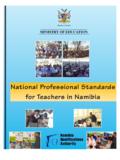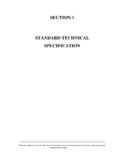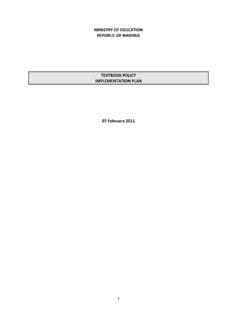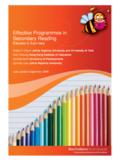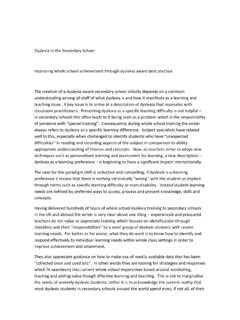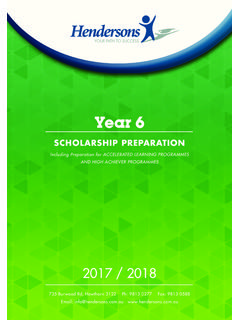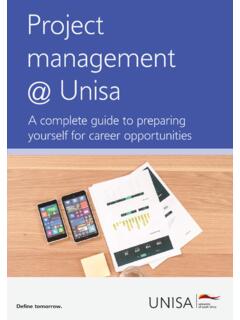Transcription of Namibia National Textbook Policy
1 Textbook Policy March 2008 March 2008 Republic of Namibia Building a Learning Nation 2 Table of Contents Explanation of terms .. 3 The Vision of the Textbook Policy .. 3 Mission of the Textbook Policy .. 3 4 Background and Context .. 4 Textbook provision: the international context .. 4 Providing textbooks to schools .. 4 Textbook supply chain: current operational status .. 5 Policy Framework .. 5 Policy Goal .. 5 Guiding Principles .. 5 Policy Objectives .. 5 Priority Policy Strategies .. 6 3 Explanation of terms Some terms used in this draft Policy require a brief explanation. Book provision: denotes the supply of learning support materials, including textbooks, to the education sector.
2 Learning Support Materials (LSMs): LSMs and textbooks are both used in this Policy as terms to describe learning materials. LSMs is regarded as a more generic term and includes non-print learning materials ( materials for the study of science and design and technology and computer software such as CD-Roms). Supply chain: This is an expression for the processes involved in bringing textbooks and other learning support materials from the hands of the author (or creator) to the end user and for linkages between author and consumers (in this case learners and teachers). Textbook : refers specifically to printed curriculum materials in book format. The Vision of the Textbook Policy The Textbook Policy aims to pave the way forward for learners in formal education to have equitable access to learning support materials (LSMs) to develop to their full potential in order to make a meaningful contribution to economic development.
3 Mission of the Textbook Policy To plan and implement an integrated, sustainable and coordinated learning support materials (LSMs) supply chain that will provide the best value, curriculum relevant textbooks and other LSMs in an equitable way to all learners and teachers. This will have a direct and measurable impact on the quality of learning opportunity for all learners. 4 Introduction The National Textbook Policy was prepared following a review of current Textbook and other learning materials development procedures and practices which included field visits and wide consultation with all stakeholders including MoE central and regional officials, representatives of commercial publishing and distribution companies, school personnel and local communities.
4 Background and Context Textbook provision: the international context Textbooks often determine what learners learn and decide what they should be taught. Teachers base their lessons on and choose lesson content from what textbooks contain. They are frequently the only reading matter students have access to and examinations are often to a considerable extent based on an ability to reproduce what is to be found in textbooks. Without a Textbook , many teachers may not be able to teach effectively. In many developing countries, where teachers might be inadequately trained, the Textbook is an indispensable resource. It is often perceived as the sole authority for what is to be taught, whereas in developed countries where a greater variety of books and reading materials are available, it may only be a supplement to learning.
5 Research has shown that textbooks are a cost-effective means of improving educational achievement, especially in the short to medium term. In countries where reading materials are scarce, they have an important role to play. Learning can be enhanced even when there is only one mediocre Textbook for every 2-3 students. Even when not mediated by a qualified and experienced teacher, textbooks can have a significant impact on educational achievement. The importance of book development as an essential pre-requisite for social and economic development is neglected nationally. The development of materials in support of curriculum implementation is a complicated and time consuming exercise, fraught with difficulties compared with, say, writing and publishing a novel.
6 An important driver for putting this new Policy in place at this time is the planned six-fold increase in government investment in LSMs over the next five years through Phase 1 of the Education and Training Sector Improvement Programme (ETSIP). This Policy will determine the nature of that essential relationship with publishers which will be modified to improve the performance of the Textbook supply chain so that it performs better, provides better value for money by reducing unit costs, and will deliver in a cost effective way, relevant learning support materials on an equitable basis. Providing textbooks to schools Textbooks are developed by publishing houses in the private sector, following the curriculum and syllabi developed by the National Institute for Educational Development (NIED).
7 The textbooks for teaching in Namibia s educationally recognized 13 languages of instruction are developed by the commercial publishers in collaboration with NIED, GTZ (Afrila) and the curriculum unit of the MoE. All textbooks in education require the evaluation and approval of NIED s curriculum panels. The approved Textbook titles are listed in the official catalogue which is sent to schools annually from which schools select books to order. Book capitation allowances are set by the regional education offices (REOs) for the schools in their region, but vary widely suggesting that REOs use different formula for calculating the per capita book allowance.
8 Book orders are reviewed by school inspectors at the circuit (district) level, consolidated at the 13 regional education offices, and sent to the contracted distributors. They raise proforma quotations and return them to REOs who check them against the school book budget and then submit to the Directorate of General Services of the MoE for procurement. The textbooks are issued to teachers who use them in the classroom as their principal instructional tools. At schools where there is adequate supply of textbooks, teachers issue the books to their learners to take books home for study and homework. 5 Textbook supply chain: current operational status The three key stages in the Textbook supply chain are evaluation and selection, procurement and delivery and payment.
9 The provision of textbooks is inadequate and seriously constrains the quality of education, especially at schools in disadvantaged and poor communities, where buying a Textbook is not an option as these are not easily available. English, mathematics and the sciences are identified as critical subjects that affect students overall performance. Policy Framework Policy Goal The Policy goal is to direct the effective and efficient planning and management of the National selection, provision and distribution of textbooks and other LSMs so as to achieve the highest standards, best value and equity in the selection, procurement and delivery of all LSMs to assist and facilitate quality learning across the curriculum for the benefit of all learners and teachers.
10 The overall objective of the Policy is to ultimately achieve a Textbook to learner ratio of 1:1 for core subjects in the first instance. At primary level this would mean eight textbooks per learner and at secondary level thirteen. With the introduction of curriculum changes over the past few years and the lack of information on current textbooks inventories at school level it is difficult to project the investment needed to reach and sustain the ideal ratios. In future the revision of curricula and textbooks will be aligned. Guiding Principles All aspects of LSMs management and the provision of LSMs to schools need to acknowledge the integrity of an integrated LSMs supply chain cycle.


